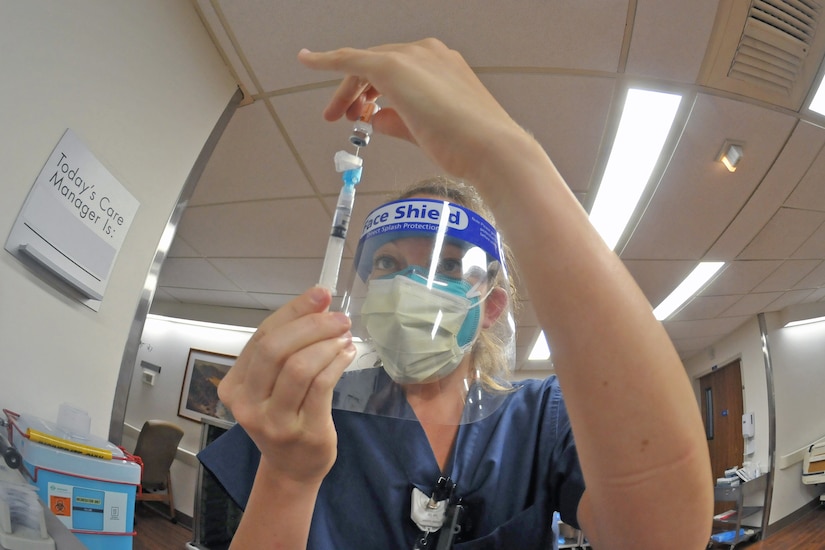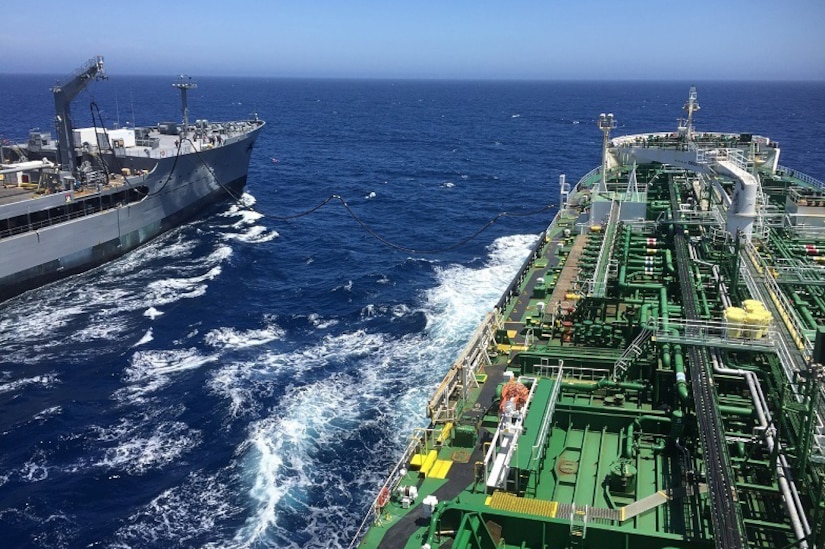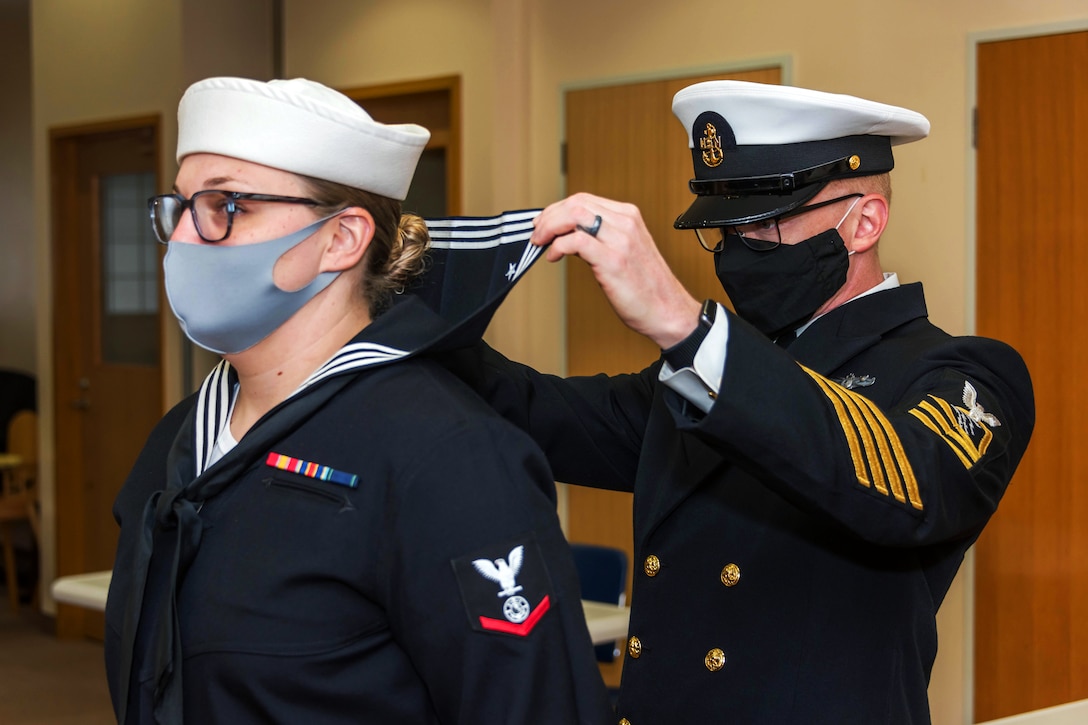Space Force 2nd Lts. Amy Coba and Elizabeth Kowal, graduates of Air University’s Officer Training School Class 20-08, recite the Space Force oath of office at Maxwell Air Force Base, Ala., Oct. 16, 2020.
Providing up-to-date information, news and original content on American Military issues.
Space Force 2nd Lts. Amy Coba and Elizabeth Kowal, graduates of Air University’s Officer Training School Class 20-08, recite the Space Force oath of office at Maxwell Air Force Base, Ala., Oct. 16, 2020.
Navy Petty Officer 2nd Class Maxwell K. McMann fires a machine gun during an exercise aboard the USS William P. Lawrence in the Caribbean Sea, Oct. 14, 2020.
Oct. 16, 2020 | BY Beth Reece , Defense Logistics Agency
The Defense Department's leading logistics agency is playing a key role in the national coronavirus response as it purchases and distributes desperately needed medical supplies for DOD and federal agencies.
By the end of September, the Defense Logistics Agency executed 21,000-plus contract actions for more than $2 billion of lifesaving medical supplies like test kits, ventilators and pharmaceutical drugs as well as personal protective equipment including masks, gloves and gowns.

Many of the items were purchased on behalf of the Federal Emergency Management Agency and the Department of Health and Human Services for state and federal governments, nursing homes, schools and the strategic national stockpile. Customers have also received food, clothing, fuel, construction materials and repair parts throughout the pandemic.
DLA's long-standing agreements with FEMA and HHS and more than a decade of logistics support during events ranging from the 2014 Ebola crisis to hurricane response prompted federal officials to leverage the agency's capabilities.
"These agreements allow for mutual support during standard operations and emergencies," Peter Battaglia, a customer relations process owner for DLA Logistics Operations who also serves on DLA's COVID-19 Task Force, said.
Using medical readiness contracts that are part of its warstopper program, DLA has provided almost 3 million N95 masks, 1 million pairs of gloves, 140,000 gowns and 10,000 face shields. Some of the items were distributed in March to military field hospitals deployed to the hardest-hit areas throughout the country. Others were used on the USNS Mercy and Comfort or prioritized for distribution by HHS and the White House supply chain task force.
DLA's warstopper-funded contracts allowed the agency to preplan for surge requirements of critical items by purchasing material in advance and paying vendors to keep it available. In one contract, the vendor agreed to make 40 ventilators available within five days of an initial order, 360 within 15 days, 400 in 30 days and so forth, said Luis Villarreal, DLA's industrial capability and warstopper program manager.
"There's no way anybody could do anything like that without the structure of our warstopper contracts," he said. An additional $12 million was invested through the program in fiscal 2020 to increase access to personal protective equipment.
As worldwide demand for personal protective equipment outpaced manufacturing capability, DLA used a rapid prototype project for advanced manufacturing to procure more than 11,000 face shields for New York City first responders in April. That same month, DLA Research and Development awarded a contract through the Small Business Innovation Research and Subsistence Network for 60 decontamination systems that can each sterilize up to 80,000 N95 masks a day. The systems were delivered in June and included six months of service and maintenance.
"DLA R&D — through SBIR, technology integrators and R&D programs — has the capability to help fund research efforts that are critical to combating COVID-19. We are actively seeking opportunities to apply R&D funding for quick wins where the technology is ready for immediate COVID response applications," David Koch, DLA's R&D director, said.
In June, DLA Troop Support began meeting FEMA requests for support for vulnerable residents and staff for more than 15,000 nursing homes. More than 30,000 deliveries of personal protective equipment like face shields and gloves were completed in August. Antigen tests that can diagnose infections in about 15 minutes are also being delivered to nursing homes this month and are a key part of decreasing COVID-19 outbreaks, said Navy Adm. Brett Giroir, HHS assistant secretary for health.
"The federal efforts to supply nursing homes with rapid point-of-care antigen instruments and tests is our highest priority to save lives, and the U.S. government will exert its authority to fulfill this mission," he said, adding that HHS would continue working with DLA to get lifesaving supplies where they're needed.
DLA troop support recently awarded a $750 million contract for 150 million rapid COVID-19 test kits that are being distributed by the vendor to state and local officials. The agency is now preparing for potential requirements during a fall surge that could include contracts for more than $1 billion in personal protective equipment like masks, goggles, face shields and gloves for the strategic national stockpile.
While DLA troop support has led procurement efforts for medical items needed by DOD and federal customers, other DLA activities have played a part, too. DLA disposition services has provided $25.4 million in excess and surplus medical supplies to non-DOD organizations in 40 states and three countries for just the cost of shipping. Tennessee officials alone have requested more than 450 medical items ranging from defibrillators and monitors to surgical bandages since March.

DLA Distribution is also storing and shipping protective equipment for Veterans Affairs health care facilities in anticipation of increased demands in the fall. Distribution process workers have remained on-site to pack and ship medical supplies, food and repair parts to deployed ships and FEMA.
Dave Kless, DLA's executive director of operations, said the agency's participation in planning efforts with FEMA, HHS, the White House supply chain task force and DOD's joint acquisition task force enabled the agency to quickly respond to demand spikes caused by COVID-19. DLA employees have been embedded in working groups at federal and DOD levels and supported U.S. Northern Command.
Trust earned through enduring relationships with industry also helped the agency ease supply chain gaps.
"We shared vital information on incoming requests with our key suppliers and discussed financial and logistics issues with them on a daily basis," he said.
To make it easier for small businesses and state and local governments to buy non-medical protective equipment, DLA launched the COVID-19 Contingency Corridor in FedMall in June.
Its role in pandemic response hasn't hindered the agency from achieving its primary goals in warfighter support, Kless continued, and material availability for some weapons systems is at an all-time high.
"Surge capacity is one of DLA's strengths and core competencies, whether that's surging for war, hurricanes, wildland fires or pandemics," he said.
Marine Corps Staff Sgt. Alex Guerrero watches an AH-1Z Viper helicopter fly after a training event on San Clemente Island, Calif., Oct. 9, 2020.
Oct. 16, 2020
Secretary of Defense Dr. Mark T. Esper conducted a call today with French Minister of the Armed Forces Florence Parly. The Secretary and the Minister discussed a range of issues, including the surge of violence in Nagorno-Karabakh, security and stability in Africa, and the situations in Iraq and the Eastern Mediterranean Sea.
On the Nagorno-Karabakh conflict, the Secretary and the Minister agreed on the need for leaders from both Armenia and Azerbaijan to implement their commitments to an immediate ceasefire in the Nagorno-Karabakh region and to a peaceful settlement.
The Secretary thanked the Minister for France’s leading role in fighting terrorism, and expressed hope more European nations will support French efforts in the Sahel.
Army Chief Warrant Officer 5, Charles Hunter, an Army Reserve senior food advisor, scans his face and his wrist at a newly installed terminal to screen for high temperatures of people entering Marshall Hall, the Army Reserve Command and Forces Command headquarters building at Fort Bragg, N.C., Sept. 29, 2020. The terminal is expected to reduce and eventually eliminate the required staffing of soldiers who currently screen people's temperatures coming into the building. The terminal scans body temperatures via the wrist to eliminate contact and stores up to 10,000 face images, which can help with contact tracing if someone is later found to test positive for COVID-19.
Army Spc. Abigail Snell, a human resources specialist assigned to the 4-6th Heavy Attack Reconnaissance Squadron, 16th Combat Aviation Brigade, receives a medical screening during the 16th CAB vaccine rodeo at Joint Base Lewis-McChord, Wash., Oct. 8, 2020. All the soldiers received medical screening and temperature checks prior to entering the vaccine rodeo in an effort to prevent possible spread of COVID-19.
Soldiers assigned to the 1st Armored Brigade Combat Team, 3rd Infantry Division, board a flight to deploy to South Korea as part of a regular rotation of forces to support the United States' commitment to Southeast Asia partners and allies at Hunter Army Airfield, Ga., Oct. 8, 2020. During the boarding process and flight, all soldiers wear masks as a COVID-19 precautionary measure.
Soldiers graduate from the 7th Army Training Command Noncommissioned Officer Academy’s Basic Leadership Course as commandant's list graduates at the Rose Barracks Theater in Vilseck, Germany, Oct.9, 2020. Due to COVID-19 restrictions, the course and graduation were conducted both in person and virtually, with the majority of the graduating class participating virtually.
Army National Guardsmen travel aboard a UH-60 Black Hawk while supporting daytime air assault training operations, Sept. 18, 2020.
Coast Guard Petty Officer 2nd Class Steven Susen observes Chief Petty Officer Steven Simpson conduct water survival training at Naval Support Activity Bahrain, Oct. 5, 2020.
Army Pfc. Sean Pratt and fellow Hawaii National Guard members assigned to Task Force Oahu tape social distancing signs on the sidewalk outside of Honowai Elementary School in preparation for the Department of Health’s annual flu vaccination in Waipahu, Hawaii, Oct. 14, 2020. Families walked-up with their children to receive their vaccine.

Navy Seaman Zebulon Brackman inspects the uniform stencil on Navy Petty Officer 3rd Class Heather E. Henson during a dress blues inspection at Naval Air Facility in Atsugi, Japan, Oct. 16, 2020. NAF Atsugi is currently taking safety precautions against COVID-19 to safeguard its service members and families on base.